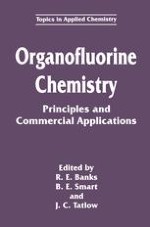1994 | OriginalPaper | Buchkapitel
Alternatives to Chlorofluorocarbons (CFCs)
verfasst von : V. N. M. Rao
Erschienen in: Organofluorine Chemistry
Verlag: Springer US
Enthalten in: Professional Book Archive
Aktivieren Sie unsere intelligente Suche, um passende Fachinhalte oder Patente zu finden.
Wählen Sie Textabschnitte aus um mit Künstlicher Intelligenz passenden Patente zu finden. powered by
Markieren Sie Textabschnitte, um KI-gestützt weitere passende Inhalte zu finden. powered by
Volatile chlorofluorocarbons (CFCs), man-made fully halogenated compounds having remarkably long atmospheric lifetimes, are implicated in the destruction of Earth’s protective stratospheric ozone layer (see Chapter 1). Studies by Lovelock in the early 1970s showed that there was a measurable concentration of trichlo-rofluoromethane (CFC-11)* in the atmosphere, suggesting that it can have a long atmospheric lifetime.1 This was followed in 1974 by the publication of a paper by Molina and Rowland, 2 in which they suggested that the chlorofluoromethanes CFCl3 and CF2Cl2 (CFC-11 and -12, respectively) might survive transport to the stratosphere, where they could be broken down photochemically releasing chlorine atoms, which would then catalyze the destruction of ozone. Bromine-containing molecules (Halons), such as CF3Br, were suspected to be even more harmful to the ozone layer. However, in the mid-70s to mid-80s, stratospheric science had not advanced enough to confirm these postulates. Because of their long atmospheric lifetimes, CFCs were also cited as possible contributors to global warming.3
